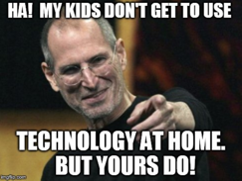“When I was a kid…” the phrase begins. What typically follows is some story in which “kids these days” are painted in some fashion that reveals their childhood was much easier and less restrictive than that of the narrator.
 The truth is, childhood experiences between generations are vastly different, but understanding why that is and how that matters when evaluating consumer opinion is the business of Rebecca Presler, Senior Qualitative Researcher and Strategist at MLN Research.
The truth is, childhood experiences between generations are vastly different, but understanding why that is and how that matters when evaluating consumer opinion is the business of Rebecca Presler, Senior Qualitative Researcher and Strategist at MLN Research.
While it is obvious that a 7-year old child and her mother have different brand and consumer preferences, one might think that is only because of the age difference. Of course, a 7-year old has different desires and tastes than that of an adult. But what expert kid UX researchers know is that there is more to the difference. Experiences of “kids these days”, even in their relatively short lives so far, constitute enough of a variance of context, that they are unlike the childhoods of their parents. In fact, they are also significantly different than those of their own slightly older and slightly younger contemporaries.
Consider this:
- Kids today are ever-younger digital natives growing up in technology-everywhere environments.
- Things that appeal to kids of a given age don’t necessarily interest those a year or two older or younger.
- Kids whose lives revolve around mobile devices and the internet see the world differently.
Gen Z was born into technology, but what comes next, Generation Alpha is poised to be the most transformative generation. This generation does not consider technology to be an add-on to life, a distraction or a tool to help optimize their lives. They simply can’t conceive of their lives without technological integration.
Enter a global pandemic. Adult's lives changed. Kid's lives changed.
The experts at MLN told us they observed two interesting changes involving kids. These changes are delineated here for consideration of how COVID may impact taste tests and UX market research with kids and their parents. The very nature of this pandemic as global and long-lasting means these issues should be understood properly and taken into account to conduct sound face-to-face UX market research when kids and parents are involved. They also reveal best practices that will last long after the pandemic is over. Rebecca was gracious enough to sit down with us and explain these observations in greater detail.
Everything Old is New Again
Pre-pandemic, one of the big trends researchers saw among parents was a move away from giving their children gifts of physical toys to giving them gifts of experiences. Millennial parents in particular were giving their kids museum memberships, adventure outings, and vacations instead of toys.
Pre-pandemic, kids were leading busy, structured lives, going from school to swim practice, soccer games, and other group activities either for themselves or in tow for one of their siblings. For nearly all of 2020, those activities were put on hold and kids were at home for far longer than they ever had been. Kids were now at home 24/7!
Pre-pandemic, kids vocalized their desire for the newest and coolest technology-based toys and they wanted themselves to be the ones to decide how to use them.

But even with the over-structured lives and total integration of technology, parents expressed that they want their kids to have analog experiences in a digital world. There have been many Silicon Valley giants who have detailed their limitation of use of the technology they created when it comes to their own children.
While typical American parents consume a greater amount of digital services and goods than their children, their general nostalgia for their more analog childhood always created a conflict of sorts. The pandemic, however, created the perfect opportunity for that desire to become a reality. With so much free time on their hands, kids were looking for different things to do.
Rummaging around in attics, closets, and basements, kids discovered toys their parents played with when they were kids. “Our own kids found my husband’s old Matchbox toy cars in the attic. They couldn’t get over how cool these old eighties-looking cars were. It was amazing how much fun they had playing with them,” said Rebecca.

There has been a sort of a reawakening to old-time, non-digital toys. Kids are enjoying playing with simple wooden toys in a different way than how they play with digital toys. The biggest difference is that there is so much more room for them to use their imaginations.
The experienced MLN team agrees that their research into pandemic play shows there is still a lot of interest in the newest and coolest tech toys, but discovered the emergence of a desire for simpler toys from simpler times. “We see it among some of the kids,” said Rebecca, “and even more so among millennial-aged parents, who want to see their kids develop their imaginations and their creativity.” We believe it will be interesting to see how kid toys and kid products balance these contrasting trends.
The Target Audience Gets Refined
Pre-pandemic kids were brought along to the grocery store, which gave them input into what would end up in the cart and ultimately, in their bellies.
Pre-pandemic kids were in restaurants, seeing the many choices of food on offer and vocalizing what they wanted to order.
“Selling to kids often involves the use of what we call pester power,” said Rebecca. “You want the kids to keep after their parents to buy your product.” McDonald's was the first big advertiser to aim at kids, let them sell the parents by nagging and annoying them until they’d break down. But during the pandemic kids were largely taken out of this equation. They were no longer at the grocery store or in restaurants where food decisions were being made.
Last year, during the pandemic, it was important to work with a dynamic recruiting partner that sourced respondents for an in-home taste test study. This project was for a snack that was a kid version of an adult favorite. The products were delivered to the homes and the follow-up interviews were conducted online. Rebecca noticed, “the kids still wanted their familiar pizzas, tacos, and cheese, of course, but the parents were more open to the idea of healthier kid versions of adult foods,” They saw an opportunity to make a decision less influenced by their kids’ opinions and more in alignment with what they perceived their kids should be eating.
Even now, as pandemic restrictions are loosening, this dynamic is shifting and parents' engagement with food options for their children is shifting. What the important takeaway is that brands really must choose if they want to aim their advertising at kids or at their parents.
Reaching Kids
With any product, if you target kids, you might use an entertainment message, focusing on how fun the product is so they become engrossed in the experience of the advertisement; motivated to pester their parents afterward.
If you target your advertisement towards parents, people who want to keep their children healthy and are looking for enrichment for their children, you might want to create a message that talks about providing them with a more creative and imagination-building experience.
With food, if you target kids, you might use a kids celebrity tie-in, or focus on the fun of the food and let them pester the parents. If you target parents. You might want to create a message that talks about their children’s health, a sustainable farming practice, or the benefits of low sugar or organic produce used.
But it’s not just about the approach of the advertising. The refinement of the target audience also means being selective about where those ads appear. It’s important for brands to match the media with the target.
Mainstream TV is not the juggernaut of advertising that it once was. YouTube usage increased significantly in March of 2020 alone. Young kids are absolutely in to YouTube and that was only greater during the pandemic. In one survey, 53% of parents reported that their children watched YouTube daily. “It’s a major channel for reaching kids across a wide range of ages. Winning brands know that traditional ways of reaching consumers just aren’t working with the Alpha Generation,” says Rebecca.
Beyond the Pandemic
No matter who you choose to target, Rebecca stresses getting back to basics when you are testing the experience people have with products for kids.
With new products, in particular, brands should always remind themselves to focus on who it is they really want to appeal to. Successful brands that target kids listen to them all the way from early product development through positioning, packaging, campaign strategy, and launch.
“At MLN, we take a kid-centric approach to taste tests and UX research. We know how to get kids to open up, be honest, and talk about what they really think,” says Rebecca. But we also know when to build studies around the parent. Getting clear and matching up the study to the right audience provides the direct insights that are key to success no matter the target audience.
Partnership with Fieldwork
Rebecca says, “Fieldwork shares our philosophy. When we work on projects with them, we really feel we’re all part of an enthusiastic team working together. Over the years, they have built a great community of kids from all kinds of different backgrounds and with different perspectives." It’s true. We love to bring energy and focus to our recruiting process as the foundation of the success of any taste test or focus group.





